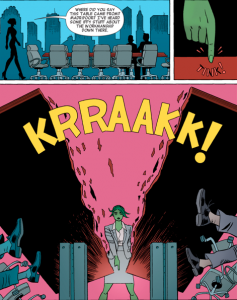She-Hulk 1
Reviewed by Will Morgan 25-Feb-14
Will Morgan reviews the latest relaunch of She-Hulk. Verdict? Legally fabulous!
Jennifer Walters, the She-Hulk – ironically, given that she was created solely as a trademark-saving Hail Mary back in the Seventies – is one of Marvel’s characters who has had a most consistent personality, and a hugely likeable one.
Razor-smart, funny, warm, courageous, passionate (in both the carnal and philosophical definitions) and insouciant, she’s a fun gal to “hang around” with on the page, and if you don’t get that, then you don’t understand the core of her, and she’s just another Big Lady Who Hits Things, a commodity with which the Marvel Universe is hardly undersupplied.
 John Byrne – hard though it may be to believe for readers of things like Triple Helix – nailed it, establishing the template for all others. Dan Slott? Masterly. Peter David let it slip at first, making a very weak start, but scrambled back with aplomb.
John Byrne – hard though it may be to believe for readers of things like Triple Helix – nailed it, establishing the template for all others. Dan Slott? Masterly. Peter David let it slip at first, making a very weak start, but scrambled back with aplomb.
Charles Soule, I am delighted to report, is right on target with the first issue, which concentrates not so much on the super-heroics (though there’s enough of that too), but on the multiple layers of legalistic and bureaucratic nonsense Jen has to deal with in her “day job”, when she’s not busy helping save the Universe.
Because She-Hulk’s basic premise is so simple even civilians can grasp it without a degree in “Marvelology”.
She’s a lawyer in a world where “super-stuff” happens.
What are the legal precedents when death, as so often in the Marvel Universe, is merely a temporary setback? Who do you sue if you have a traumatic “origin” that changes your life irrevocably? If you’re fast-forwarded fifty years into the future, can you grab your estate back from your heirs? What is the legal standing of robots, androids, cyborgs, ghosts, demons and wraiths? Are you responsible for the actions of your parallel-world counterpart?
These are the sort of problems Jen deals with, while staving off the forces of evil and generally kicking arse, and Soule – who is, I am informed, a lawyer himself – gets right in there with a glorious re-introduction to the character. Jen, tired of being exploited by her employers who expect her to bring lucrative super-hero contacts to their firm, strikes out on her own, and promptly becomes enmeshed in a copyright dispute between the widow of a deceased villainous henchman and Tony Stark/Iron Man, Jen’s colleague in the Avengers and occasional bedmate. Soule strikes all the right notes in the ensuing dispute; he gives a new reader enough to hang their brain on even if they have no previous knowledge of Jen, introduces elements clearly and engagingly, and meshes the courtroom dramas, personal relationships and superheroics with a refreshing twist.
Javier Pulido’s artwork I’m somewhat less attracted by. Blocky, primal and rough-hewn, it looks like Shaky Kane if he was really really making an effort, which still isn’t a look that appeals to me much – sorry, Shaky! – and lacks the flexibility of facial expression, the nuance of body language, that Jen’s best previous interpreters have brought to her. Other people have raved about it, so I’m prepared to concede that it’s a matter of taste.
It doesn’t really matter, though, because the best She-Hulk comics are to be read, rather than looked at; the story is strong, the dialogue sparkling, the characterization spot-on.
Everyone will love “The Jen” – she’s not just for transvestite Moloids any more!

Having squared off against aliens, robots, and super-villains, Jen is thwarted by her greatest challenge - Tony Stark's legal department!


One of the many things I like about this comic is that the superheroics are so underplayed – indeed, the big fight scene in this issue takes place entirely in the gutter between pages. It’s another comic like Black Widow that takes the Hawkeye template of what the character does when they’re not being an Avenger. (When we get round to the Captain America variant it will be entirely him reading history books about Lincoln and Roosevelt and listening to show tunes.)
On the art, fair enough, not to your taste. But isn’t it great that Marvel are putting art like this in superhero comics? I was chatting to Hazel Robinson and she was saying stuff like this, David Aja in Hawkeye, Phil Noto on Black Widow, Adrian Alphona on Ms. Marvel and Valerio Schiti on Journey Into Mystery, Marvel are showing that not all superhero comics have to look like they’re drawn by Rob Liefeld. I remember the 1980s, and sure, there was Bill Sienkewicz way out on his own, but if you ignore him, and stick with the likes of John Byrne, George Perez, Keith Giffen (before he got strange), Dave Cockrum, and even Frank Miller and Walt Simonson, and mainstream superhero comics just weren’t covering the same range of artistic expression as Marvel’s do now.
I also love the long explanation of all the Stark companies there’ve been.